
The Curtiss Falcon was a family of military biplane aircraft built by the American aircraft manufacturer Curtiss Aeroplane and Motor Company during the 1920s. Most saw service as part of the United States Army Air Corps as observation aircraft with the designations O-1 and O-11, or as the attack aircraft designated the A-3 Falcon.
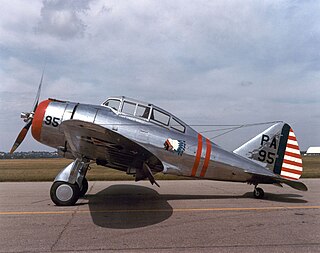
The Seversky P-35 is an American fighter aircraft built by the Seversky Aircraft Company in the late 1930s. A contemporary of the Hawker Hurricane and Messerschmitt Bf 109, the P-35 was the first single-seat fighter in United States Army Air Corps to feature all-metal construction, retractable landing gear, and an enclosed cockpit.

The Vought SBU-1 Corsair was a two-seat, all-metal biplane dive bomber built by Vought Aircraft Company of Dallas, Texas for the US Navy. Its design was based upon the F3U-1 two-seat fighter that was abandoned when the Navy decided not to obtain any more two-seat fighters.
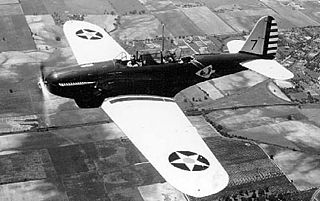
The Consolidated P-30 (PB-2) was a 1930s United States two-seat fighter aircraft. An attack version called the A-11 was also built, along with 2 Y1P-25 prototypes and YP-27, Y1P-28, and XP-33 proposals. The P-30 is significant for being the first fighter in United States Army Air Corps service to have retractable landing gear, an enclosed and heated cockpit for the pilot, and an exhaust-driven turbo-supercharger for altitude operation.

The Boeing Model 15 is a United States single-seat open-cockpit biplane fighter aircraft of the 1920s, manufactured by the Boeing company. The Model 15 saw service with the United States Army Air Service and with the United States Navy as a carrier-based fighter.

The Boeing XP-4 was a prototype American biplane fighter of the 1920s. It was grounded permanently after just 4.5 hours of flight testing.
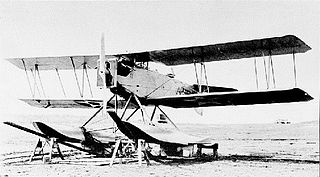
The Aeromarine AS was a seaplane fighter aircraft evaluated by the US Navy in the early 1920s.

The LUSAC-11 is an early American two-seat fighter aircraft. It was a French design, commissioned and built in the United States during World War I and ordered in large numbers by the United States Army Air Corps, but these were canceled at the end of the war, and only 30 were built. The type was used for experimental purposes, setting several altitude records during the 1920s.

The Loening PW-2 was a 1920s American single-seat monoplane fighter designed by Grover Loening and built by his Loening Aeronautical Engineering Company.
The Beardmore W.B.IV was a British single-engine biplane ship-based fighter of World War I developed by Beardmore. Only one was built.
The Beardmore W.B.II was a British biplane fighter prototype of the 1910s.
The Sopwith 8F.1 Snail was a prototype British Fighter aircraft of the First World War. It was unsuccessful, being abandoned due to an unreliable engine.
The Bristol Type 6 T.T.A was a British two-seat, twin-engine biplane, designed in 1915 as a defence fighter. Two prototypes were built, but the T.T.A. did not go into production.
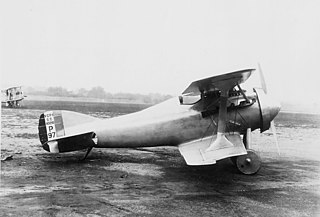
The Verville VCP was an American single-engined biplane fighter aircraft of the 1920s. A single example of the VCP-1 was built by the United States Army Air Service's Engineering Division, which was later rebuilt into a successful racing aircraft, while a second, modified fighter was built as the PW-1.
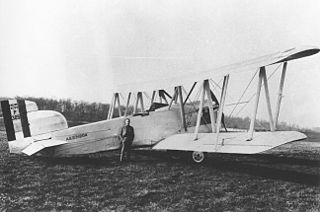
The Engineering Division TP-1 was a two-seat biplane fighter designed by Alfred V. Verville and Virginius E. Clark at the United States Army Air Corps Engineering Division. A second aircraft was completed as an observation biplane and designated the Engineering Division XCO-5.

The Farman F.30A C2 was a two-seat biplane designed as a fighter in France in 1916 and powered by a single, water-cooled radial engine. It showed poor flight characteristics and only one was built, though it was modified twice. It should not be confused with the similarly named Henry Farman HF.30 of 1915, a completely different aircraft which was used in large numbers by the Imperial Russian Air Service.
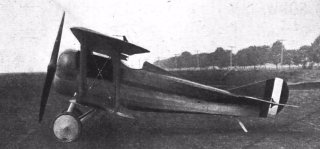
The Orenco B was a prototype American fighter aircraft of World War I. It was a single-engined, single-seat biplane that flew in 1918. Although it demonstrated good performance, it did not enter large scale service.

The Wibault 12 Sirocco or Wib 12 Sirocco was a two-seat, parasol wing fighter aircraft designed and built in France in the 1920s. Three fighter prototypes were completed, one for the RAF and two Army co-operation variants. There was no series production.

The LFG Roland D.XV was a World War I German single-seat fighter aircraft ordered as a test bed for engine comparisons. It was distinguished from earlier Roland biplane designs by the elimination of flying wires. Two later aircraft, also called LFG Roland D.XV, were completely different designs with slab-sided fuselages.
The LVG D.IV was a German fighter plane built by LVG in World War I.
















